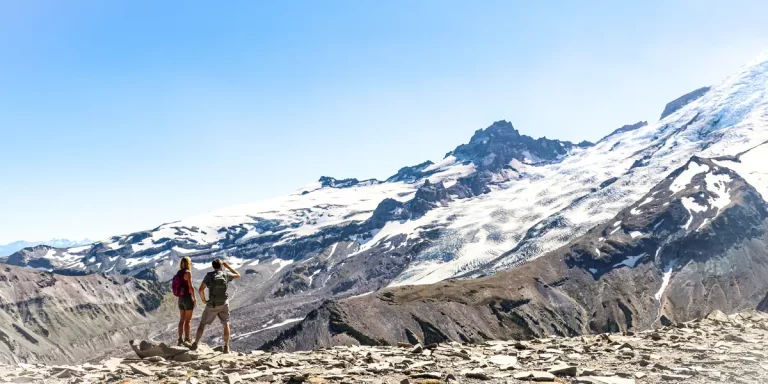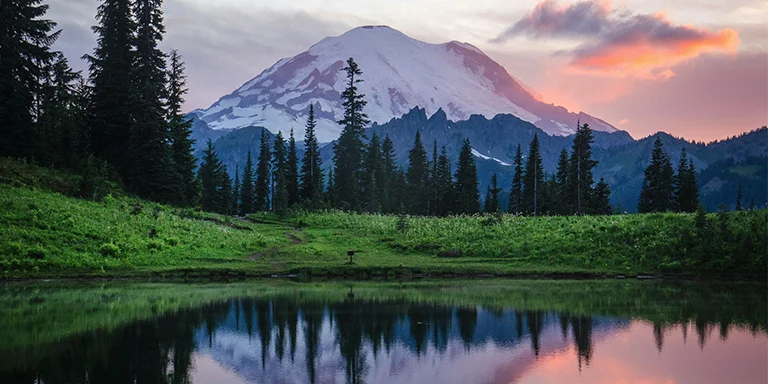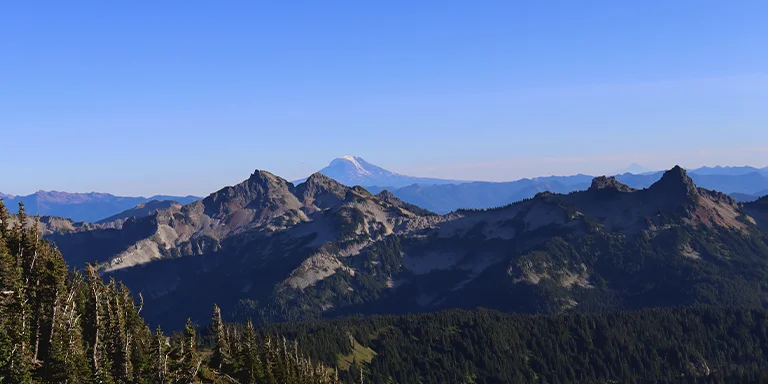

Backpacking in Washington offers immense variety for outdoor enthusiasts, from the rugged North Cascades to windswept coastal trails, including popular destinations like the Olympic Coast.
And that’s what this post is all about – backpacking in Washington. We’ll provide tips to help you prepare for backpacking in this diverse state as well as showcase the TOP 5 multi-day trails in Washington.
Interested? Let’s get started!
In our opinion, these are the best multi-day trails Washington has to offer:

Length: 85.8 mi / 138.1 km
Type: Loop
Difficulty: Hard
Elevation Gain: 24 547 ft / 7482 m
Location: Mount Rainier National Park
Estimated Hiking Calorie Burn: 11 607 calories
More Details: See on AllTrails
Encircling Mount Rainier, the renowned 93-mile Wonderland Trail passes through diverse landscapes from lush forests to subalpine meadows.
This iconic multi-day backpacking loop sees steep elevation gains up to 7,000 feet as it traverses the slopes of Rainier. Along the way, take in views of glaciers, waterfalls, and wildflowers while keeping watch for wildlife like black bears, mountain goats, and ptarmigan. Due to its length and high elevation, the Wonderland Trail is best hiked over 10-14 days in summer and early fall when snow has melted out.
Permits, bear canisters, and careful planning required. Rewarding yet challenging, the Wonderland Trail showcases the very best of Mount Rainier National Park.

Length: 36.4 mi / 58.58 km
Type: Out and back
Difficulty: Hard
Elevation Gain: 10 879 ft / 3316 m
Location: Glacier Peak Wilderness
Estimated Hiking Calorie Burn: 4908 calories
More Details: See on AllTrails
The challenging 36-mile out-and-back Glacier Peak Trail climbs over 7,000 feet through forest and meadows to reach the 10,541-foot summit of remote Glacier Peak. Prepare for steep switchbacks, scrambling over boulders, and crossing snowfields to arrive at sweeping views of surrounding peaks and glaciers. Due to exposed, rugged terrain near the summit, mountaineering skills and equipment may be necessary. Hiking from mid-summer to early fall allows easier passage andrequires permits for overnight camping. A strenuous yet rewarding adventure for experienced backpackers.

Length: 30.8 mi / 49.57 km
Type: Loop
Difficulty: Hard
Elevation Gain: 9619 ft / 2932 m
Location: Mount Rainier National Park
Estimated Hiking Calorie Burn: 4200 calories
More Details: See on AllTrails
The challenging 31-mile Northern Loop circles the northwest side of Mount Rainier, treating hikers to stunning alpine scenery. Traversing subalpine meadows filled with wildflowers in summer, this strenuous 2-3 day backpack has steep elevation gains up to 7,000 feet as it climbs in and out of river valleys. Highlights include turquoise Berkeley Park, breezy Tolmie Peak, and tranquil viewpoints at Eunice Lake and Mowich Lake. Permits required for overnight camping in the backcountry. Get an intimate look at the rugged northwest corner of Mount Rainier on this iconic loop.

Length: 35.1 mi / 56.5 km
Type: Out and back
Difficulty: Hard
Elevation Gain: 5633 ft / 1717 m
Location: Olympic National Park
Estimated Hiking Calorie Burn: 4250 calories
More Details: See on AllTrails
The challenging 35-mile out-and-back Blue Glacier Trail climbs over 4,500 feet through temperate rainforest and alpine meadows to reach the icy Blue Glacier on Mount Olympus. Prepare for steep switchbacks, traversing a ladder up a rocky cleft, and spectacular views of the glacier and surrounding peaks from the lateral moraine. Overnight permits required for camping at designated backcountry sites like Elk Lake. Due to popularity, start early to avoid crowds on the trail and at the glacier viewpoint. A strenuous yet iconic hike in the heart of Olympic National Park.

Length: 142 mi / 228.5 km
Type: Point to point
Difficulty: Hard
Elevation Gain: 26 584 ft / 8103 m
Location: Gifford Pinchot National Forest
Estimated Hiking Calorie Burn: 17 600 calories
More Details: See on AllTrails
Stretching 142 miles from the Columbia River to White Pass, this section of the epic Pacific Crest Trail traverses diverse landscapes from forest to alpine. The trail climbs over rugged Goat Rocks Wilderness and Old Snowy Mountain, topping out at over 7,000 feet. Prepare for challenging elevation gains through this remote section with limited resupply options. Permits required for overnight camping at backcountry sites. From famed viewpoints to the stunning wildflower meadows of Goat Rocks, experience the beauty of the PCT as it crosses southern Washington.
The Pacific Northwest’s fickle weather means backpackers should be prepared for sudden storms and temperature drops anytime:
Prior to choosing your gear, review the weather data for Washington (Tacoma):
| Jan | Feb | Mar | Apr | May | Jun | Jul | Aug | Sep | Oct | Nov | Dec | |
|---|---|---|---|---|---|---|---|---|---|---|---|---|
| High °F | 48 | 51 | 56 | 60 | 66 | 71 | 77 | 77 | 21 | 61 | 53 | 47 |
| Low °F | 37 | 37 | 40 | 43 | 48 | 53 | 56 | 56 | 52 | 46 | 40 | 36 |
| Rain/Snow (D*) | 18 | 15 | 18 | 15 | 12 | 9 | 5 | 5 | 7 | 13 | 19 | 18 |
Not sure if Washington is right for you?
Don’t forget to check out our backpacking guides for Montana and Oregon.
When backpacking in Washington, building campfires takes preparation. Fires are only allowed in established fire pits within designated campgrounds, never in wildland areas which can ignite easily.
Get ready for weather changes with rain gear and extra food and layers. Bring a map, compass, or GPS, and know how to use them. Tell someone your plans. Watch out for dangers like falling trees, flooded streams, and steep drops. Use a bear-resistant food canister and follow storage rules. Check for ticks after leaving the trail. Carry first-aid supplies. Don’t approach or feed wild animals. Follow burning bans and campfire rules.
Avoid approaching or feeding wildlife to prevent aggressive behavior. Black bears are common but usually shy; make noise on trails to avoid surprising them. If threatened, stand your ground and use bear spray. Cougars rarely attack, but be cautious with children and make noise in dense areas. Check for ticks after leaving the trail and remove them within 24 hours to prevent disease. In higher elevations, steer clear of areas with marmots, which can carry bubonic plague. Pay attention to signs about nesting birds, like spotted owls, to avoid disturbing their habitat.
When planning a backpacking adventure in Washington’s scenic wilderness, budgeting is key to ensure you are prepared. Factor in costs for quality gear like a sturdy backpack, weatherproof tent, sleeping bag, and hiking boots. Don’t skimp on essentials like food, water filters, and first aid kits. Determine fees for park permits and campsites. Budget extra for gas and incidentals. Allow wiggle room for unexpected expenses on the trail. With a little research and planning, Washington’s natural splendor can be experienced on any budget by backpackers willing to spend smartly on gear, fees, and provisions needed for a rewarding trip immersed in nature.